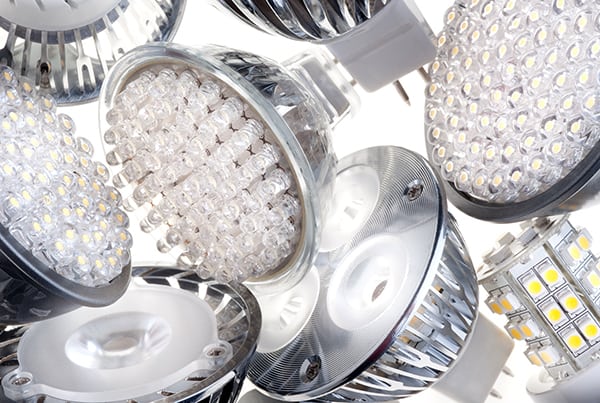
Above: LED lamps are available in a wide variety of styles and variations which arrange arrays of surface mounted diodes in different configurations. Photo by Dusan Kostic, DepositPhotos.
BitDepth#1033 for March 22, 2016
Last week I placed my second order for a batch of household LED lights, following up on an earlier, exploratory purchase in October 2015.
I love new technologies, but I’m always wary about the Big New Thing, which invariably comes with its own gotchas, bugs and except-for-thats.
Until quite recently, all the buzz around the household bulb was about compact fluorescent lamps or CFLs.
These lamps, a dramatically scaled down version of the tubular, bitter green and blue tubes that came to be synonymous with office lighting, cost more than the incandescent lamps which had served as the basis for artificial lighting since the time of Thomas Edison, but lasted far longer.
This was an excellent equation for home owners, who must have noticed that bottom-line conscious businesses had long embraced fluorescent lighting as good business.
But household CFLs had a tough time of it when they were introduced. For one thing, early bulbs were huge, and didn’t fit stylish fixtures designed for the shape of traditional incandescents.
Early colour was also a problem, since flourescents don’t burn, they emit light by exciting a gas trapped between two electrodes in a sealed tube and that light is notably deficient in colour wavelengths.
The twin whammy of sickly colours in both the office and the home drove manufacturers to formulate new gases which drifted to more natural cool colours as well as the warmer colours associated with the reassuring burn of an incandescent bulb.
Soon you could get your CFLs in flavours of colour, usually cool white or warm white, both still starved of the full range of the spectrum, but designed more agreeably for the expectations of the human eye.
Unfortunately, CFLs are now having a tough time of it again, as discussions arise about the mercury content of the gas formulations inside those sealed bulbs.
It turns out that a broken CFL momentarily emits toxic levels of mercury vapor well in excess of allowable exposure.
These bulbs offer no warnings about this potentially dangerous health risk, and currently accepted practice in dealing with a broken CFL bulb is to vacate the room immediately until it disperses, followed by cleanup, which should include placing the broken glass and bulb into a sealed glass container or at least a properly sealed plastic bag.
Environmental Protection Agency researchers report problems removing mercury from carpeting for weeks after breakage.
This development is new enough that formal systems for handling and recycling these dangerous waste products are still being implemented in the US and Europe, and people still dump whole CFLs into the garbage where they are certain to break.
Enter light emitting diodes (LEDs), which are basically an amplification of the tiny bulbs that have made their way into our flashlights and other small scale uses for more than a decade now.
LEDs hit most of the gracenotes that CFLs did when they were introduced. They last longer and draw far less electricity than incandescents, an advantage that scales up dramatically in industrial applications, where a 54 watt draw gets you the light equivalent of a 300 watt bulb.
The development of these bulbs has been rapid, easily five times the speed of the CFL evolution and that’s left a lot of older, bulkier LED bulbs on the market.
I don’t like the warm white versions of LEDs, but their cool white variants (5000k) are more pleasingly neutral than CFL equivalents.
If you shop carefully and stick to newer models, most are drop-in equivalent in incandescent fixtures, provide pleasing light. For only a small price premium, you can get dimmable versions of most lights.
Security conscious homeowners will be surprised at the crisp, bright light of 100w equivalent LED flood lamps.
New “corncob” lamps, which look nothing like any light fixture you’ve ever seen, promise industrial area lighting in a standard screw mount fixture with 65 – 100 watt incandescent power draw.
LEDs also draw a bit less electricity per lumen than flourescents, promise longer life, don’t flicker visibly and turn on at full strength instantly, without the warmup time associated with CFLs.
As next big things go, they are a very attractive proposition.


